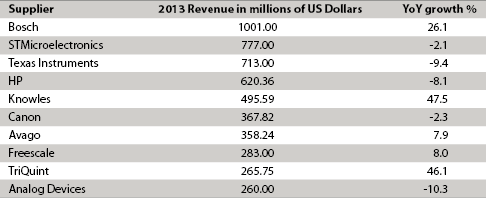

When we talk about size, it is useful to have a frame of reference, so consider these tangible examples:
• 1 millimetre (mm) (1 * 10-3 metres) – the diameter of a pinhead.
• 100 micron (μm) (100 * 10-6 metres) – the average width of a strand of human hair.
• 10 nanometre (nm) (10 * 10-9 metres) – the lower size of particles in tobacco smoke.
• 0.1 nanometre (1 * 10-10 metres) – the approximate size of a molecule of water.
It requires quite a stretch of the imagination to make the leap from visualising objects the width of a human hair to visualising something one thousand or more times smaller. And an even greater stretch to think about machines (electro-mechanical devices) made up of components of that order of magnitude – and yet the incorporation of such machines in industrial, medical and consumer goods will be a reality within this decade.
While nanometre devices are out on the horizon, the use of micron scale devices is already pervasive – in fact, readers using a smartphone to read this article may well have 10 or more such devices in the palms of their hands.
Microtechnology refers to technology with features in the range of one to one hundred microns (micrometres), while nanotechnology refers to technology with features in the range of one to one hundred nanometres.
MEMS, aka microelectromechanical systems, are miniaturised systems embracing both electrical and mechanical phenomena and are classified as either sensors (converting mechanical phenomena into electronic signals) or actuators (converting electronic signals into mechanical phenomena). NEMS, aka nanoelectromechanical systems, are the nanometre siblings of MEMS.
MEMS
MEMS are a key enabler and beneficiary of the Internet of Things and Industry 4.0, offering pervasive and continuous sensing of physical and environmental phenomena at low-cost. In 2006, the unit price for a MEMS device was in the order of US$7.00. Today, unit prices have shrunk to around US$0.60, driven by double-digit compound annual growth rate in demand for MEMS, which has been the result of the incorporation of multiple sensors and, to a lesser extent actuators, in smartphones, gaming devices, other consumer electronics, vehicles, medical devices and diagnostic systems.
One indication of the proliferation of MEMS devices is the September 2014 announcement by STMicroelectronics[1] that it has shipped five billion MEMS sensors and three billion micro-actuators to date.
Shipments of MEMS-based microphones grew 37% from 1.9 billion (valued at US$609m) in 2012 to 2.6 billion (valued at US$833) in 2013[2]. As unit prices have tumbled in step with increased volumes, more potential microphone applications have become economically viable; stereo recording on consumer devices has replaced mono systems; internal microphones have replaced bulky external microphones; manufacturers have added microphones to monitor background noise so that it can be cancelled out; automotive manufacturers are now incorporating microphones in safety systems and using MEMS microphones for knock sensors in internal combustion engine control systems; and microphones can be incorporated in manufacturing production systems and rotating machinery to provide continuous monitoring of the mechanical health of assets.
While the market size for MEMS microphones is impressive, it is exceeded by the markets for MEMS pressure sensors, gyroscopes, accelerometers and inkjet print heads.
Other MEMS devices of interest to instrumentation and control and motion control practitioners include gas and chemical sensors, flow sensors, pressure, humidity and temperature sensors, infrared sensors, ultrasonic sensors and LIDAR devices.
As MEMS technology has matured, devices have progressed from measuring only a single physical characteristic to integrated sensors making multiple physical measurements on a single monolithic MEMS component. For instance the STMicroelectronics ASM330LXH automotive inertial module[3] comprises a 3D accelerometer, a 3D gyroscope and a temperature sensor. The demand for such Inertial Measurement Units is increasing for automobile, robotic and personnel location applications in densely developed urban settings and in buildings where signals from global positioning systems are unable to penetrate and also in automobile stability applications.
Smart sensors combine processing capability with MEMS devices so that sensing related algorithms can be executed at the sensor level, reducing the need for communications with the main processor and offloading processing workload from the main processor. This can help to reduce power requirements and extend battery life on mobile devices.
MEMS benefits
Some of the benefits of MEMS over earlier technology macro sized sensors are obvious – smaller footprint, lower mass, lower energy consumption in operation and lower per unit cost. Others are less obvious – lower energy consumption to manufacture, less raw material used in manufacture, lower environmental impact at end of life, lower thermal and mechanical inertia, more robust.
Lower thermal inertia translates to faster response to changes in temperature. Lower mechanical inertia can also mean reduced measurement time constants and greater tolerance to mechanical shock.
The data sheet[4] for STMicroelectronics LPS22HB MEMS nano pressure sensor illustrates several of these characteristics:
• Smaller footprint: 2 mm x 2 mm x 0.76 mm.
• Lower energy consumption: Down to 4.0 μA.
• More robust: Overpressure capability 20x full scale, dust-free and water resistant.
• Greater tolerance to mechanical shock: Shock survivability 22 000 g.
• Lower thermal inertia: Output temperature data rate programmable up to 75 Hz.
• Lower mechanical inertia: Output pressure data rate programmable up to 75 Hz.
Jockeying for position
The top 10 suppliers of MEMS by revenue in 2013[5], the latest year for which data are available, are shown in the table.

From the year-on-year growth figures, readers will deduce that this is a dynamic supply market where those suppliers that have managed to become the dominant supplier to the right application area, such as the automotive sector, or tied in key customers like Apple and Samsung can achieve significant year-on-year growth.
The performance of Bosch in 2013 reflects the fact that they have succeeded in becoming the dominant supplier to the automotive sector and have also secured significant contracts with Apple, Samsung and other manufacturers of mobile devices.
Glossary
MEMS
Micro-Electro-Mechanical Systems, or MEMS, is a technology that in its most general form can be defined as miniaturised mechanical and electro-mechanical elements (i.e., devices and structures) that are made using the techniques of microfabrication. The critical physical dimensions of MEMS devices can vary from well below one micron on the lower end of the dimensional spectrum, all the way to several millimetres. The main criterion of MEMS is that there are at least some elements having some sort of mechanical functionality whether or not these elements can move<sup[6]</sup>.
NEMS
Nanoelectromechanical systems (NEMS) are a class of devices integrating electrical and mechanical functionality on the nanoscale. NEMS form the logical next miniaturisation step from so-called microelectromechanical systems, or MEMS devices. NEMS typically integrate transistor-like nanoelectronics with mechanical actuators, pumps, or motors, and may thereby form physical, biological, and chemical sensors[7].
References
1. STMicroelectronics: Press release, http://tinyurl.com/oddwd9z
2. IHS Technology: Industry report, http://tinyurl.com/mo5bdtz
3. STMicroelectronics: Data brief, http://tinyurl.com/kyx3dab
4. STMicroelectronics: Datasheet – target specification, http://tinyurl.com/pk873k7
5. IHS Technology: Press release, http://tinyurl.com/ogmvpw4
6. MNX: Web site, http://tinyurl.com/9p49mos
7. Wikipedia: Web site
About the author

Andrew Ashton has electrical, mechanical and business qualifications and has been active in automation and process control since the early 1980s. Since 1991 he has headed up a company that has developed formulation management systems for the food, pharmaceutical and chemical manufacturing industries and manufacturing solutions involving the integration of various communication technologies and databases. Developed systems address issues around traceability, systems integration, manufacturing efficiency and effectiveness. Andrew is a contributing editor for SA Instrumentation and Control.
| Tel: | +27 11 543 5800 |
| Email: | [email protected] |
| www: | www.technews.co.za |
| Articles: | More information and articles about Technews Publishing (SA Instrumentation & Control) |

© Technews Publishing (Pty) Ltd | All Rights Reserved